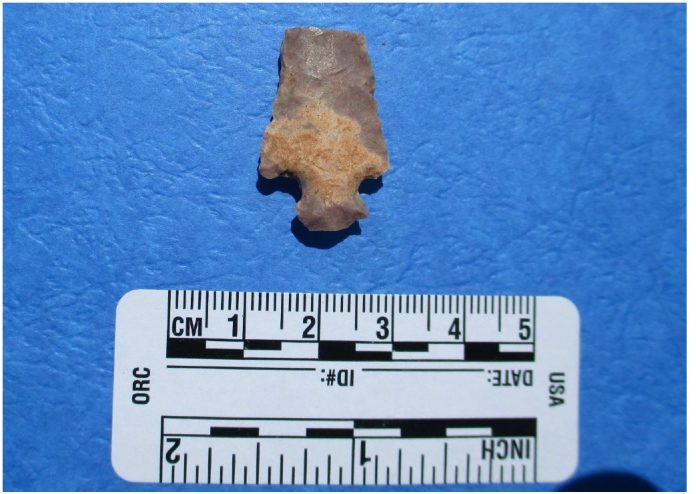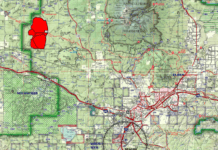
A team of archaeologists hired by Yavapai County to survey the Verde Connect project area between State Route 260 and Beaverhead Flat Road discovered five previously unrecorded prehistoric and historic sites, including two new prehistoric sites deemed significant enough to be eligible for the National Register of Historic Places.
One of the two prehistoric sites recommended for eligibility is a concentration of 5,000 to 10,000 pieces of a “distinct, white chert” representing waste stone from tool production, ranging from small flakes to larger chunks of the stone.
The waste stone is a byproduct of making arrow points, hammers, scrapers and other stone tools from larger pieces of chert, a hard sedimentary rock. The archaeologists interpret the site as a toolmaking space for ancient residents and a quarry for gathering raw stone to work elsewhere.
The other new site recommended for historic status contained a wider range of artifacts than any other site in the report, including a “well-made” trough grinding stone, or mano, projectile points, a piece of unworked turquoise and pottery imported from the north, Tusayan white ware. The pottery pieces observed included one of the oldest types of Tusayan white ware, Kana’a black on white type, dated by archaeologists to between A.D. 825 and 1025.
The artifacts led the team to speculate that the site could be a “Southern Sinaguan long-term occupation site,” possibly used for habitation, in the period of A.D. 800 to 1160.
The report noted that the site might hold information on Southern Sinaguan “trade and exchange,” among other insights, presumably because of the presence of exotic materials and traded pottery.
These findings were included in the cultural survey team’s final report, made available — with exact locations redacted — by the sponsors of the Verde Connect project. Yavapai County, the primary sponsor of Verde Connect, proposes to build new roads connecting Cornville Road and Middle Verde Road with State Route 260.
The cultural survey report, prepared by Michael Stubing and colleagues, was conducted as part of Verde Connect’s environmental assessment. Environmental assessments are required by federal law and are used to outline the cultural and environmental impacts from proposed development projects in a transparent way and also help project sponsors make plans to minimize damage to resources.
The cultural resource survey for Verde Connect also identified historic sites from the Euro-American settlement — sites and artifacts from roughly the 1860s onward. Two findings from the report touching U.S. settlement history will mean potentially less preservation work for project planners. First, researchers determined the General Crook Road, a historic road developed in 1872 from Fort Apache in eastern Arizona to Fort Whipple in Prescott, runs to the south of the Verde Connect project area and would not be affected by the proposed roads.
A transmission line associated with the Child-Irving Hydroelectrical Facilities — the first hydroelectric system in Arizona, constructed between 1907 and 1916 — runs through the project area, but all the equipment associated with the line in the project area is modern, with no historic artifacts related to the power plant found.
The most noteworthy U.S. period feature in the Verde Connect area is a section of the OK Ditch, an in-use irrigation ditch built in 1876, believed to be among the first built by American farmers in the Verde Valley. According to the report, the ditch also has significance for the Yavapai-Apache Nation.
“In the early twentieth century, as the Yavapai and Apache peoples began to reestablish their homeland in the Verde Valley, the OK Ditch provided water to 450 acres of farmland in the boundary of the Middle Verde Reservation of the Yavapai-Apache Nation,” the report states.
A Verde Connect road would have to span the OK Ditch. The report recommends that “a standalone archival report be prepared to fully document the site.”
Verde Connect’s draft assessment determined the project would have an overall “adverse effect” on cultural resources in the project area and outlines a plan to mitigate the harm.
The assessment states that the two newly recorded prehistoric sites deemed eligible for historic status, the white stone quarry and the long-term occupation site, “cannot be avoided by project construction” and propose “data recovery” if the project proceeds. Data recovery means excavating and collecting as much information as possible about the sites before they are destroyed or damaged by construction activities.
The public comment period for Verde Connect’s draft environmental assessment ended in late May. The assessment will be finalized using the comments received, after which there will be a draft decision issued followed by a 45-day objection period.





















